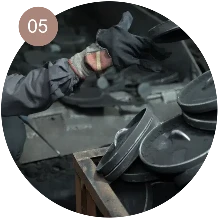
Benefits of Using an Iron Dosa Pan for Perfect Indian Crepes
The Iron Dosa Pan A Culinary Essential for Authentic Indian Cuisine
The iron dosa pan, a simple yet crucial tool in Indian kitchens, embodies the rich culinary heritage of India. Dosa, a popular South Indian dish made from fermented rice and lentil batter, is more than just a meal; it is a celebration of flavors, traditions, and techniques passed down through generations. The choice of cooking surface significantly influences the texture and taste of the dosa, making the iron dosa pan indispensable for many cooks.
Why Choose an Iron Dosa Pan?
One might ask, why opt for an iron dosa pan over a non-stick or aluminum alternative? The answer lies in the unique properties of cast iron. Cast iron is renowned for its heat retention and even heat distribution, which are vital for achieving the perfect dosa—crispy on the outside and soft on the inside. This cookware allows for a high degree of temperature control, enabling chefs to experiment with different cooking techniques, from slow-roasting to quick frying.
Moreover, cooking with an iron dosa pan brings added health benefits. Iron cookware releases trace amounts of iron into the food, a bonus for those looking to increase their iron intake, particularly in vegetarian diets where iron-rich foods may be limited. Using traditional iron pans also promotes eco-friendly cooking practices, as they are durable, long-lasting, and free from harmful chemicals found in many non-stick coatings.
Care and Maintenance
To enable longevity and optimal performance of the iron dosa pan, proper maintenance is essential. Unlike non-stick pans, cast iron requires a bit more care but rewards users with excellent cooking performance over time. Initially, one must season the pan, which involves applying a thin layer of oil and heating it to create a non-stick surface. This process not only protects the iron from rust but also enhances the pan’s cooking performance.
iron dosa pan

After each use, it is important to clean the pan with minimal soap and to dry it thoroughly before storing it. Regular seasoning is recommended to maintain its non-stick properties and to prevent the development of rust. With a bit of love and attention, an iron dosa pan can last for generations, making it a valuable investment for any culinary enthusiast.
Cooking the Perfect Dosa
Using an iron dosa pan requires some practice, but once mastered, it opens up a world of delicious possibilities. To cook a perfect dosa, one must begin with a well-fermented batter, ideally left overnight. Preheating the pan adequately is crucial; a sprinkle of water should sizzle when the pan is hot enough. Pour a ladleful of batter and spread it in a circular motion to form a thin layer. The key lies in the timing; a dosa typically takes just a few minutes on each side. Once golden brown, it can be flipped and served hot with a side of chutney and sambar, a lentil-based vegetable stew.
As you experiment with the dosa pan, you may also venture into other recipes traditionally prepared on iron surfaces, such as uthappam (thick pancakes with toppings), cheela (savory pancakes made from chickpea flour), and even various grilled dishes. The versatility of an iron dosa pan allows home cooks to explore a wide range of culinary delights.
Conclusion
The iron dosa pan is not merely a cooking utensil; it is a gateway to embracing the traditions and flavors of Indian cuisine. Its unique properties make it an essential tool for anyone who loves cooking and wishes to elevate their culinary skills. By incorporating this age-old cookware into your kitchen, you can enjoy not just food but a slice of culture, history, and the joy that comes with sharing meals made with love. Whether you are a seasoned chef or a beginner, an iron dosa pan will surely enhance your cooking experience and fill your kitchen with delightful aromas.
-
Season Cast Iron Perfectly with GPT-4 Turbo TipsNewsAug.01,2025
-
High Quality Cast Iron Cookware - Baixiang County Zhongda MachineryNewsAug.01,2025
-
Premium Cast Iron Pan: Durable & Perfect HeatNewsAug.01,2025
-
High Quality Kitchen Durable Black Round Cast Iron Cookware Pancake Crepe Pan-Baixiang County Zhongda Machinery Manufacturing Co., Ltd.NewsAug.01,2025
-
Cast Iron Cookware - Baixiang County Zhongda Machinery | Nonstick, Heat ResistanceNewsAug.01,2025
-
High Quality Kitchen Durable Black Round Cast Iron Cookware - Baixiang County Zhongda Machinery | Non-Stick, Heat Retention, DurableNewsJul.31,2025


